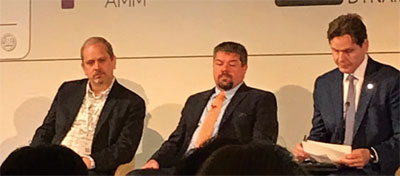If politics is indeed driving a wedge between Americans today, then nowhere is this more visible than in the steel sector which is mired in a verbal battle between the steel-making and steel-consuming industries on the issue of steel import tariffs under Section 232 of the Trade Act, whose imposition for reasons of national security is contested by the opponents.
The question of steel tariffs also dominated the three-day Steel Success Strategies conference, the 34th edition, held in the latter half of June in New York where representatives of steel-supplying nations such as China, Japan, Korea, India, Turkey, Germany, etc., worried by growing American protectionism, had also descended. Comments by some US steel executives at the conference suggested that the tariffs had indeed checked the “inundating steel imports”, besides resulting in a sharp rise in domestic production and sales, and a surge in profitability.

Nucor’s CEO John Ferriola, making a dramatic “landing” on the stage via a visual spacecraft to hammer down the message that Nucor was involved in making special spacecraft bodies (out of steel, naturally!) since the summer of 1969. An elated Ferriola - remember his past statement that “it’s a great time to make steel in America”? – said that demand for steel was projected to grow to over 1.7 billion metric tonnes by the end of this year. “Unemployment in the US is at its lowest since five years … Nucor posted the highest earnings in its history in 2018. We do not just sell steel to our customers … we sell them solutions! The US manufacturing sector earned its highest earnings since this century,” he exclaimed to the thunderous applause from the packed auditorium.
Bernhard Hoffmann, Vice President (Engineering/Product Development) at US Steel Corp., the largest integrated steel producer in the US and the largest North American tubular producer, with a 22 million tons annual steelmaking capability, told the conference delegates that OEMs would continue to invest in autonomous and electric vehicles which constitute a significant source of steel consumption though the emphasis will be on “cost-effective lightweighting”, as Hoffmann put it, for the vehicle structures and improved drive motor efficiency. US Steel continues to invest in technology to help produce advanced high structural steels (AHSS).
Many of the delegates, representing a variety of industries and services, privately told the American Journal of Transportation that after tariffs were raised on steel, aluminum and other products, prices had risen. However, the prices had, meanwhile, fallen from those high levels for a variety of reasons across the industries; if the weakness continued, companies might struggle to make money from their new investments. There were fears that such a situation might lead to a steel glut.
But steel companies disagree, arguing that the market can absorb the new capacity. Executives say they have carefully considered their investments and expect them to do well through the economy’s ups and downs.
According to Ferriola, steel capacity was not being added “just to add tons” and that the bulk of the investment was based on producing greater high-margin, value-added products and not commodity-grade steel. But Ferriola also acknowledged the uncertainties in the trade though he seemed, generally, optimistic about 2019.
The tariffs did initially reduce steel imports, generating more domestic demand in 2018 and boosting profits. With abundant cash in hand and added money coming from corporate tax cuts provided by President Trump, US steelmakers began adding more capacity than they would have done otherwise. However, as the global economy cools down and demand falls, electric arc furnace companies, armed with higher profit margins, want to have a bigger share of the US market. This could possibly lead bigger companies to poach on the weaker ones, in the process of consolidation.
Peter Marcus, managing partner at World Steel Dynamics, speaking at the SSS-conference, said that Trump’s USA-China trade war is causing economic apprehension, and that an “economic chill” was devastating the global economy and the steel industry.
He maintained that 50% of China’s exporting manufacturers planned offshore units, and China’s manufacturing prowess advantage was lessened because of huge wage boosts since 2000, and new technologies available to all. “China’s export armada is de-fanged,” he said.



